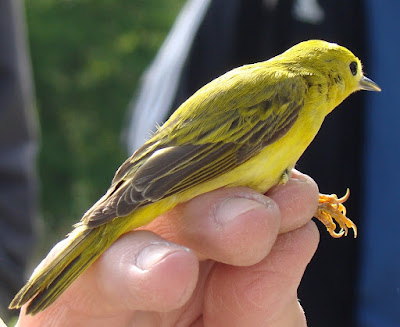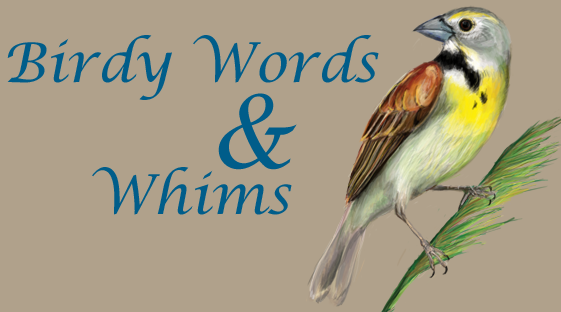Wow, today was a really successful day at the banding station. We had about 10 or 11 birds, half of which were male orioles. It was so great to see that bright orange plumage up close. Walking to the prairie from the woods, you could tell that the trees were alive with birdsong. The summer resident Indigo Buntings were back at their usual perches and Common Yellowthroats were busy chasing Chickadees away from their favorite shrubs. An Eastern Kingbird teased us by perching just a few feet away from the nets and Scarlet Tanagers were chirping away in the distance. We also had a Warbling Vireo in the trees next to our set-up

This American Goldfinch was my first bird of the day. There was a whole flock of goldfinches sitting atop the net, wondering how to save their friend. But this guy was the only one who got stuck. If you see the strange color on his lower beak, we assumed that he had gotten stained by gorging himself on berries.
 Here I am with the male goldfinch. I was able to extract him from the net by myself. It's really good that I'm getting some practice and feeling more confident doing this. It can be a really tricky and nerve-wracking process!
Here I am with the male goldfinch. I was able to extract him from the net by myself. It's really good that I'm getting some practice and feeling more confident doing this. It can be a really tricky and nerve-wracking process!
 One of our 5 gorgeous male Baltimore Orioles. This was definitely a mature male judging by the brilliant coloring. Some of the younger males were a little yellower in color and had a few orange feathers sticking out of their heads.
One of our 5 gorgeous male Baltimore Orioles. This was definitely a mature male judging by the brilliant coloring. Some of the younger males were a little yellower in color and had a few orange feathers sticking out of their heads.
 This Common Yellowthroat wasn't being very patient for the camera and thought he could fly away. I banded another one right after I had this one. Both were males. Like the other two species mentioned, Common Yellowthroats are dimorphic species, meaning that the male and female have distinctly different plumages. The female Common Yellowthroat doesn't have the black mask and has a paler yellow throat. The females can be hard to distinguish from other warblers, especially after many birds molt their bright summer plumages.
This Common Yellowthroat wasn't being very patient for the camera and thought he could fly away. I banded another one right after I had this one. Both were males. Like the other two species mentioned, Common Yellowthroats are dimorphic species, meaning that the male and female have distinctly different plumages. The female Common Yellowthroat doesn't have the black mask and has a paler yellow throat. The females can be hard to distinguish from other warblers, especially after many birds molt their bright summer plumages.
 I was about to say that I thought we had all male birds this morning, but we did have one female Yellow Warbler. Unless this was a young male, I don't remember now! But the mature males are much brighter yellow and have bright orange streaking on the breast.
I was about to say that I thought we had all male birds this morning, but we did have one female Yellow Warbler. Unless this was a young male, I don't remember now! But the mature males are much brighter yellow and have bright orange streaking on the breast.
 With this Robin, I needed a little help getting him out of the net. It sure didn't help that he literally screamed when I was trying to remove the net from his wing. If you ever heard a rabbit scream, you'll know what it sounds like when a bird screams. But boy, was he beefy. It would help at this point to have bigger hands, because I couldn't keep his feet from kicking all over the place with my bander's grip. I needed a couple people to help me just to put the band on. I hope to go on and band even larger birds someday, so that will make for another kind of adventure.
With this Robin, I needed a little help getting him out of the net. It sure didn't help that he literally screamed when I was trying to remove the net from his wing. If you ever heard a rabbit scream, you'll know what it sounds like when a bird screams. But boy, was he beefy. It would help at this point to have bigger hands, because I couldn't keep his feet from kicking all over the place with my bander's grip. I needed a couple people to help me just to put the band on. I hope to go on and band even larger birds someday, so that will make for another kind of adventure.

This robin was so fidgety, I was a little afraid to hold him by his feet. But thanksfully, Jerry, another extremely helpful volunteer held the Robin for a nice pose. The Robin didn't want to fly away at first, and we worried that something was wrong with his wing. This can happen sometimes and banding can be stressful on the bird. He did manage to fly away eventually, so he may have just been getting over the shock a little bit. It's hard to guess how an inidividual bird will take the experience of being banded, but we try to minimize the stress as much as possible. If anything does go wrong, and the bird gets injured, our plan of action is to take them to a nearby animal rehabilitation hospital. But hopefully that won't happen.

 This American Goldfinch was my first bird of the day. There was a whole flock of goldfinches sitting atop the net, wondering how to save their friend. But this guy was the only one who got stuck. If you see the strange color on his lower beak, we assumed that he had gotten stained by gorging himself on berries.
This American Goldfinch was my first bird of the day. There was a whole flock of goldfinches sitting atop the net, wondering how to save their friend. But this guy was the only one who got stuck. If you see the strange color on his lower beak, we assumed that he had gotten stained by gorging himself on berries.









No comments:
Post a Comment